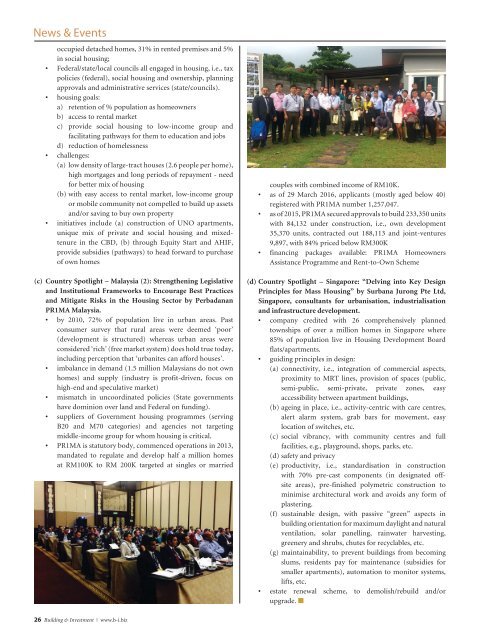Building Investment (May - Jun 2016)
Global demand remains lacklustre in 2016 as most of the world’s key players and many emerging-market economies are performing below their potential. As we enter into the second half of the year, growth estimates remain unchanged for most Asian countries. However, business must go on and we are seeing property launches picking up again. Investors are still out there hunting for bargains and some of the reasonably-priced property units are still being snapped up....
Global demand remains lacklustre in 2016 as most of the world’s key players and many emerging-market economies are performing below their potential. As we enter into the second half of the year, growth estimates remain unchanged for most Asian countries. However, business must go on and we are seeing property launches picking up again. Investors are still out there hunting for bargains and some of the reasonably-priced property units are still being snapped up....
You also want an ePaper? Increase the reach of your titles
YUMPU automatically turns print PDFs into web optimized ePapers that Google loves.
News & Events<br />
<br />
<br />
<br />
<br />
occupied detached homes, 31% in rented premises and 5%<br />
in social housing;<br />
Federal/state/local councils all engaged in housing, i.e., tax<br />
policies (federal), social housing and ownership, planning<br />
approvals and administrative services (state/councils).<br />
housing goals:<br />
a) retention of % population as homeowners<br />
b) access to rental market<br />
c) provide social housing to low-income group and<br />
facilitating pathways for them to education and jobs<br />
d) reduction of homelessness<br />
challenges:<br />
(a) low density of large-tract houses (2.6 people per home),<br />
high mortgages and long periods of repayment - need<br />
for better mix of housing<br />
(b) with easy access to rental market, low-income group<br />
or mobile community not compelled to build up assets<br />
and/or saving to buy own property<br />
initiatives include (a) construction of UNO apartments,<br />
unique mix of private and social housing and mixedtenure<br />
in the CBD, (b) through Equity Start and AHIF,<br />
provide subsidies (pathways) to head forward to purchase<br />
of own homes<br />
(c) Country Spotlight – Malaysia (2): Strengthening Legislative<br />
and Institutional Frameworks to Encourage Best Practices<br />
and Mitigate Risks in the Housing Sector by Perbadanan<br />
PR1MA Malaysia.<br />
by 2010, 72% of population live in urban areas. Past<br />
consumer survey that rural areas were deemed ‘poor’<br />
(development is structured) whereas urban areas were<br />
considered ‘rich’ (free market system) does hold true today,<br />
including perception that ‘urbanites can afford houses’.<br />
imbalance in demand (1.5 million Malaysians do not own<br />
homes) and supply (industry is profit-driven, focus on<br />
high-end and speculative market)<br />
mismatch in uncoordinated policies (State governments<br />
have dominion over land and Federal on funding).<br />
suppliers of Government housing programmes (serving<br />
B20 and M70 categories) and agencies not targeting<br />
middle-income group for whom housing is critical.<br />
PR1MA is statutory body, commenced operations in 2013,<br />
mandated to regulate and develop half a million homes<br />
at RM100K to RM 200K targeted at singles or married<br />
couples with combined income of RM10K.<br />
as of 29 March <strong>2016</strong>, applicants (mostly aged below 40)<br />
registered with PR1MA number 1,257,047.<br />
as of 2015, PR1MA secured approvals to build 233,350 units<br />
with 84,132 under construction, i.e., own development<br />
35,370 units, contracted out 188,113 and joint-ventures<br />
9,897, with 84% priced below RM300K<br />
financing packages available: PR1MA Homeowners<br />
Assistance Programme and Rent-to-Own Scheme<br />
(d) Country Spotlight – Singapore: “Delving into Key Design<br />
Principles for Mass Housing” by Surbana Jurong Pte Ltd,<br />
Singapore, consultants for urbanisation, industrialisation<br />
and infrastructure development.<br />
company credited with 26 comprehensively planned<br />
townships of over a million homes in Singapore where<br />
85% of population live in Housing Development Board<br />
flats/apartments.<br />
guiding principles in design:<br />
(a) connectivity, i.e., integration of commercial aspects,<br />
proximity to MRT lines, provision of spaces (public,<br />
semi-public, semi-private, private zones, easy<br />
accessibility between apartment buildings,<br />
(b) ageing in place, i.e., activity-centric with care centres,<br />
alert alarm system, grab bars for movement, easy<br />
location of switches, etc.<br />
(c) social vibrancy, with community centres and full<br />
facilities, e.g., playground, shops, parks, etc.<br />
(d) safety and privacy<br />
(e) productivity, i.e., standardisation in construction<br />
with 70% pre-cast components (in designated offsite<br />
areas), pre-finished polymetric construction to<br />
minimise architectural work and avoids any form of<br />
plastering.<br />
(f) sustainable design, with passive “green” aspects in<br />
building orientation for maximum daylight and natural<br />
ventilation, solar panelling, rainwater harvesting,<br />
greenery and shrubs, chutes for recyclables, etc.<br />
(g) maintainability, to prevent buildings from becoming<br />
slums, residents pay for maintenance (subsidies for<br />
smaller apartments), automation to monitor systems,<br />
lifts, etc.<br />
estate renewal scheme, to demolish/rebuild and/or<br />
upgrade. <br />
26 <strong>Building</strong> & <strong>Investment</strong> | www.b-i.biz


















